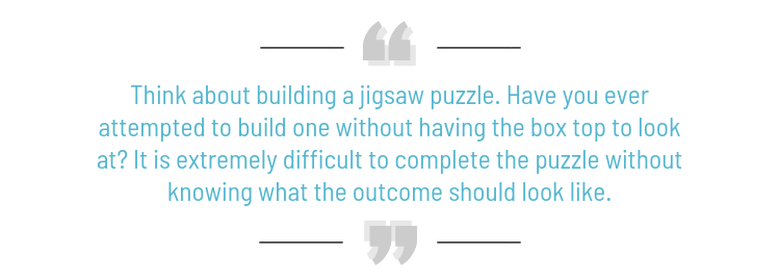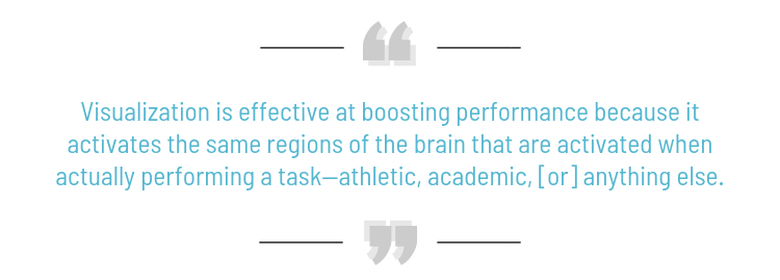
One of the practices that contributes to Michael Phelps’ success as a swimmer takes place well before he gets into the pool. As part of his training regimen, Phelps visualizes every detail of his race—from responding to something going wrong (like ripping his suit) to crossing the finish line ahead of his competitors.
Phelps has used visualization (along with other training methods, of course) to achieve incredible things in his career, like winning 28 Olympic medals to become the most decorated Olympian of all time. But you don’t need to be a world-class athlete to borrow his tricks—and I’m living proof.
Visualization has played an absolutely essential part in hitting a number of my career goals, such as pitching high-profile clients with confidence, scaling my business to six figures, and tackling large, complex projects without feeling completely overwhelmed. My visualization practice has, in many ways, acted as the bridge between where I am in my career at any given moment to where I want to be—by allowing me to see and feel my future success before it actually happens.
“Think about building a jigsaw puzzle. Have you ever attempted to build one without having the box top to look at? It is extremely difficult to complete the puzzle without knowing what the outcome should look like,” says executive leadership coach Cynthia Corsetti. “You may fit pieces together, you may get bits and pieces of the puzzle done, but it will take longer, be more challenging, and possibly never reach completion.”
Corsetti believes the same is true of your career; the more clear and detailed you are when you visualize what you want from your career, the easier it will be to make it a reality.
Of course, while visualization can definitely help you improve performance, for the best results, you need to pair it with action. Phelps didn’t just visualize himself winning races—he also spent hundreds and hundreds of hours in the pool.
Want to give visualization a try? Here’s what you need to know to get started.
Visualization 101 What’s Visualization?
Before we jump into how visualization can completely transform your career, let’s quickly cover what, exactly, visualization is.
“Visualization is the ability to create a clear picture in your mind of the exact circumstance you wish to create,” says Corsetti. “It has also been called setting intention, attraction, and ‘positive thinking,’” she adds. It’s “an actual skill that a person can learn.”
Visualization is seeing, feeling, and completely embodying a future outcome—whether that’s snagging the corner office, completing a marathon, or buying your dream home—before it happens. By creating your desired future outcome in your mind in as much detail as possible, you can actually transform your visualization into reality.
The Science How Does Visualization Actually Work?
When you visualize yourself hitting a specific goal, your brain interprets that imagery as reality—and, as a result, creates new neural pathways to support that reality.
“Visualization is effective at boosting performance because it activates the same regions of the brain that are activated when actually performing a task—athletic, academic, [or] anything else,” says Roselyn Smith, a licensed psychologist, hypnotherapist, and management consultant. “It actually changes the pattern of our electrochemical brain waves.”
In other words, by using visualization, you’re tricking your brain into acting as if your desired outcome—whether that’s nailing a presentation, landing a big promotion, or launching your own business—has already happened. And because your brain thinks your desired outcome has already happened, you’re more likely to take the actions necessary to align with your brain’s perceived reality.
Visualization can even cause physical changes. One study found that participants who visualized workouts were able to increase their muscle mass by 13.5% over the course of 12 weeks—even though they never stepped foot inside a gym. (Imagine how much more they’d have gained if they’d actually worked out!)
The Exercises What Visualization Exercises Can I Do to Be More Successful at Work?
So research has shown that visualization can work. But how, in practice, do you use it to make you more successful? Here are a few exercises to get you started.
Start With Basic Visualization
If you’re just hopping on board the visualization train, you’re going to want to start with the basics. Carve out a few quiet minutes each day to sit down, close your eyes, and picture where you want to go, who you want to be, and what you want to do in your career. You can start small (like picturing yourself rocking an upcoming presentation) or go big (like celebrating your first six-figure year in business).
The key to this exercise is being as specific as possible. See what’s going to happen clearly in your mind. Home in on all the small details, from what you’re wearing to the way you’re speaking. And let yourself experience the emotions that go along with the visualization (so, for example, the sense of pride you’d feel when landing a raise or the rush of excitement you’d get when you launch a new product). The more realistic you can make your visualization, the more effective it’ll be.
Picture the Worst-Case Scenario
There are bound to be obstacles on any career journey. With visualization, you can anticipate what they’ll be—and come up with a plan so you know exactly how to handle them when they arise.
Let’s say, for example, that you’re gearing up to pitch a new project idea to your team. Visualize all the things that could go wrong—your presentation crashes, you forget important information in the middle of your pitch, your team says they’re not interested—and, more importantly, how you’ll handle them.
Entrepreneur Tim Ferriss calls this “fear-setting;” basically, you spend time imagining all the potential worst-case scenarios and how you’d navigate them. This way, you’ll be prepared and have a game plan if and when it happens, and you’ll be much more likely to succeed as a result.
Focus on Specific Skills or Goals
As the previously mentioned study showed, practicing a task in your mind can yield measurable results—even if you never practice that task IRL.
Want to become a better public speaker? Spend time visualizing yourself speaking to large crowds. Want to increase the number of potential clients you speak to each day? Picture yourself hitting the phones and connecting with tons of prospects each day. The point is, the more you practice the skill in visualizations, the better you’ll be at said skill in reality.
Write it Down
Have a hard time visualizing things in your mind? No worries! Writing down your visualizations can be just as effective as picturing them in your head—perhaps even more so.
“I have my clients write a story that describes in detail what they want their future to look like—down to the pictures on the wall of their office,” says Corsetti. “Adults learn by using all their senses. By writing the exercise they are using their thoughts as well as the physical activity of writing which seals the idea and makes it more concrete.”
The Next Steps What Else Do I Have to Do?
Clearly, visualization is a powerful tool. But here’s an important reminder: If you want to see real results, you need to pair it with tangible actions. You can visualize yourself calling up 100 client prospects a day—but if you never actually pick up the phone, you’re not going to get the results you’re looking for.
It’s “more than just ‘think about it and it will happen,’” says Corsetti. “You see, when you visualize yourself as a leader, or as an entrepreneur...you have to start to respond [and act] as you would in that role.”
So, for example, if you’re visualizing yourself landing a coveted promotion, in addition to picturing yourself in this new role, you need to start acting as if you’re already in it, whether that means taking on more responsibility, mentoring newer members of your team, or logging extra hours at the office.
And when you pack this one-two punch—visualization and action? “Opportunities begin to present themselves. You attract people and circumstances that will help you get there,” Corsetti explains. “It literally steps up your game on a daily basis.”
Visualization is like a roadmap for that old saying—if you can dream it, you can achieve it. Because the right exercises can help you imagine the career you want. And with that vision, plus the corresponding actions, you can start making it a reality.




